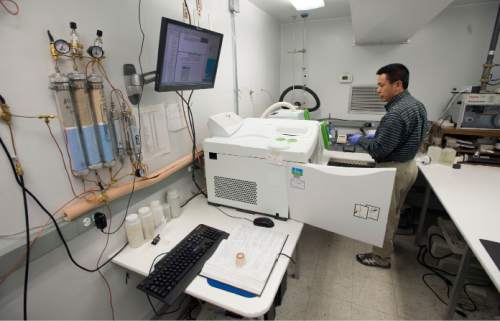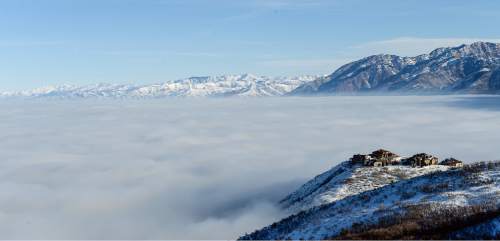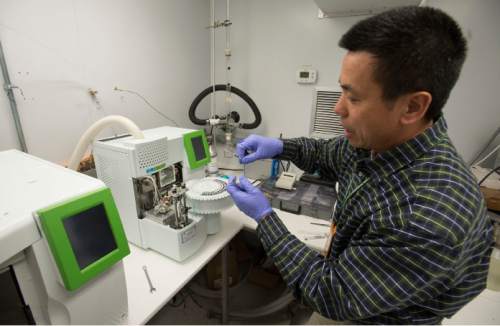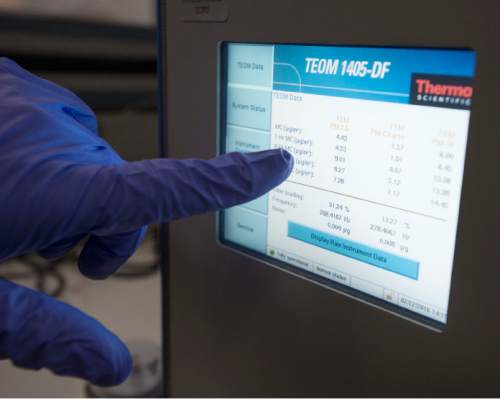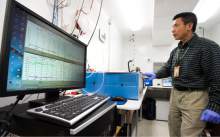This is an archived article that was published on sltrib.com in 2016, and information in the article may be outdated. It is provided only for personal research purposes and may not be reprinted.
Air quality is a hot topic in the Legislature, but it's come with some frustrations for environmental advocates, who say that while the public is interested in discussing the issue, Utah's leaders don't seem particularly interested in listening.
The broad offering of proposals related to air quality is encouraging to Ingrid Griffee, executive director of Utah Moms for Clean Air. But activists who have taken time off work or away from other personal responsibilities to attend hearings have gone home unheard when discussions are unexpectedly tabled, or when the number of people allowed to comment is curtailed in the interest of time.
"More and more it seems it's becoming difficult for people to make their voices heard in the Capitol," Griffee said.
Griffee said committee leaders seem more apt to place time limits on public comment this year. In some crowded hearings, only a set number of public comments have been allowed. At times, she said, it has felt as though lawmakers were intentionally shutting down certain points of view.
"The people have shown over and over again that we want bold action on air quality," she said. "In the end, it's still a bit of an uphill battle sometimes."
State environmental regulators are fighting their own uphill battle, finding limited success in acquiring funding for several initiatives, including the Utah Division of Air Quality's popular CARROT program.
Created by the legislature in 2014, CARROT offered grants to individuals and businesses willing to exchange polluting properties for cleaner technology. The program spawned several well-received smaller projects, such as the lawn mower exchange. But the Natural Resources, Agriculture and Environmental Quality Appropriations Subcommittee did not prioritize CARROT, or Clean Air Retrofit, Replacement, and Off-Road Technology, for funding during its voting last week.
The DAQ also did not receive the funds it requested for expanding and upgrading its monitoring programs. Some Utah communities, such as Cedar City, have grown to the point that they now require regular air monitoring, said DAQ director Bryce Bird. And about 46 percent of the division's existing air monitors have surpassed their estimated five-year lifespan, making equipment failures more likely, Bird said.
Two such failures occurred earlier this month, during one of the worst inversions the state has experienced in recent years. Both failures — one in Cache County, the other in Salt Lake City — prevented Utahns from obtaining accurate, up-to-date air quality data, Bird said, sometimes showing the air as virtually pollution-free when levels were truly much higher.
The division requested a $2.2 million one-time appropriation for new monitoring equipment, plus an ongoing appropriation of $400,000, and received $1 million in one-time funding and $200,000 ongoing.
With the limited funding, Bird said, the division will have to dedicate the monies it does have to the required expansion and make do elsewhere with the equipment it already has.
The Salt Lake City monitor had a backup that was brought online within a day, Bird said, and the Cache County monitor was replaced within a week with a monitor from another location when repair attempts failed.
Not all failures are addressed so quickly. Last summer, a monitor station in Bountiful was out of commissions for almost three months, Bird said, when the monitor failed and the division could not find a suitable replacement.
The division did see a major funding victory in the Infrastructure and General Government Appropriations Subcommittee, which granted the Utah Department of Environmental Quality $6.2 million for the construction of a new laboratory. The lab will serve all of the divisions within the DEQ, including the Division of Air Quality.
Another victory came to the division Monday evening, as SB49, which would increase the statute of limitations for environmental code violations from one year to two years, obtained its second favorable recommendation from the House Judiciary Committee.
Due to limited resources, the DAQ is unable to inspect all facilities with air quality permits on an annual basis, bill sponsor Sen. Luz Escamilla, D-Salt Lake City, told the committee. Consequently, Bird testified, there have been circumstances where an inspector has discovered an air quality violation after the window to prosecute the offender has passed.
"We need to give our state regulators the tools they need to enforce the laws that we have," Rep. V. Lowry Snow, R-St. George, said.
But discussion of another air quality bill, HB250, was tabled during an earlier hearing on Monday afternoon when the bill's sponsor, who was presenting to another committee, was unable to attend.
Bird said HB250 would fill in an important gap potentially left by the passage of HB316, the controversial comprehensive bill for updating the state building code.
HB316 does reinstate the Air Quality Board's water heaters rule, which was placed on a legislative sunset list by an interim committee last fall, but it only requires the installation of ultra-low nitrogen oxide emitting water heaters in new homes and contracted remodels that fall under the state building code. That accounts for about 20 percent of the water heater installations during any given year in the state, Bird said. To catch the other 80 percent — installed by a plumber or purchased directly by the homeowner — the division needs a bill like HB250 to limit the wholesale and retail sale of water heaters to those models that qualify as ultra-low NOx emitters.
According to a recent study from the Utah Foundation, limiting the sale of water heaters in Utah would reduce emissions from area sources like homes and buildings by almost 5 percent. Between 2012 and 2014, the study estimated, that the water heaters rule could have reduced by 20 percent the number of times Utah exceeded the Environmental Protection Agency's standard for fine particulate pollution.
HB316, which would adopt parts of the 2015 International Efficiency Conservation Code as recommended by the state's Uniform Building Code, has come under fire for language that would increase the interval at which the state legislature must review the building code, and for language that would restrict the circumstances under which the DEQ and associated regulatory bodies like the Air Quality Board could adopt new rules that might overlap with the state building code. That bill obtained a favorable committee recommendation earlier this month and is now awaiting a reading on the House floor.
Another related bill, which would adopt the recommended 2015 energy code in its entirety, has yet to come before a legislative committee. The Utah Foundation estimates the energy code would save buyers of newly built homes an estimated $3,750 over the term of the average mortgage and reduce pollutants in Utah's air by 1,500 tons per year.
The trio of building emissions bills have drawn attention from activists due to DAQ projections that area sources, including buildings and homes, will soon overtake vehicles as the No. 1 source of emissions on the Wasatch Front.
Clean energy is also a top issue this year, with Rocky Mountain Power's controversial STEP proposal drawing heavy fire from all sides, and several other bills calling for various incentives for alternative fuel vehicles.
Twitter: @EmaPen


